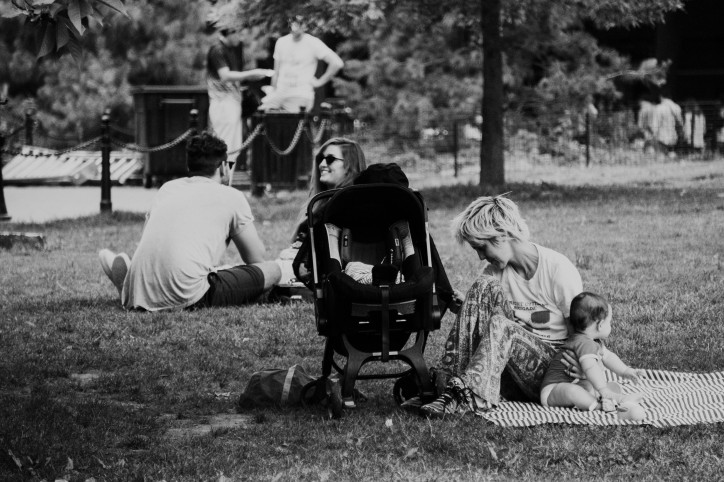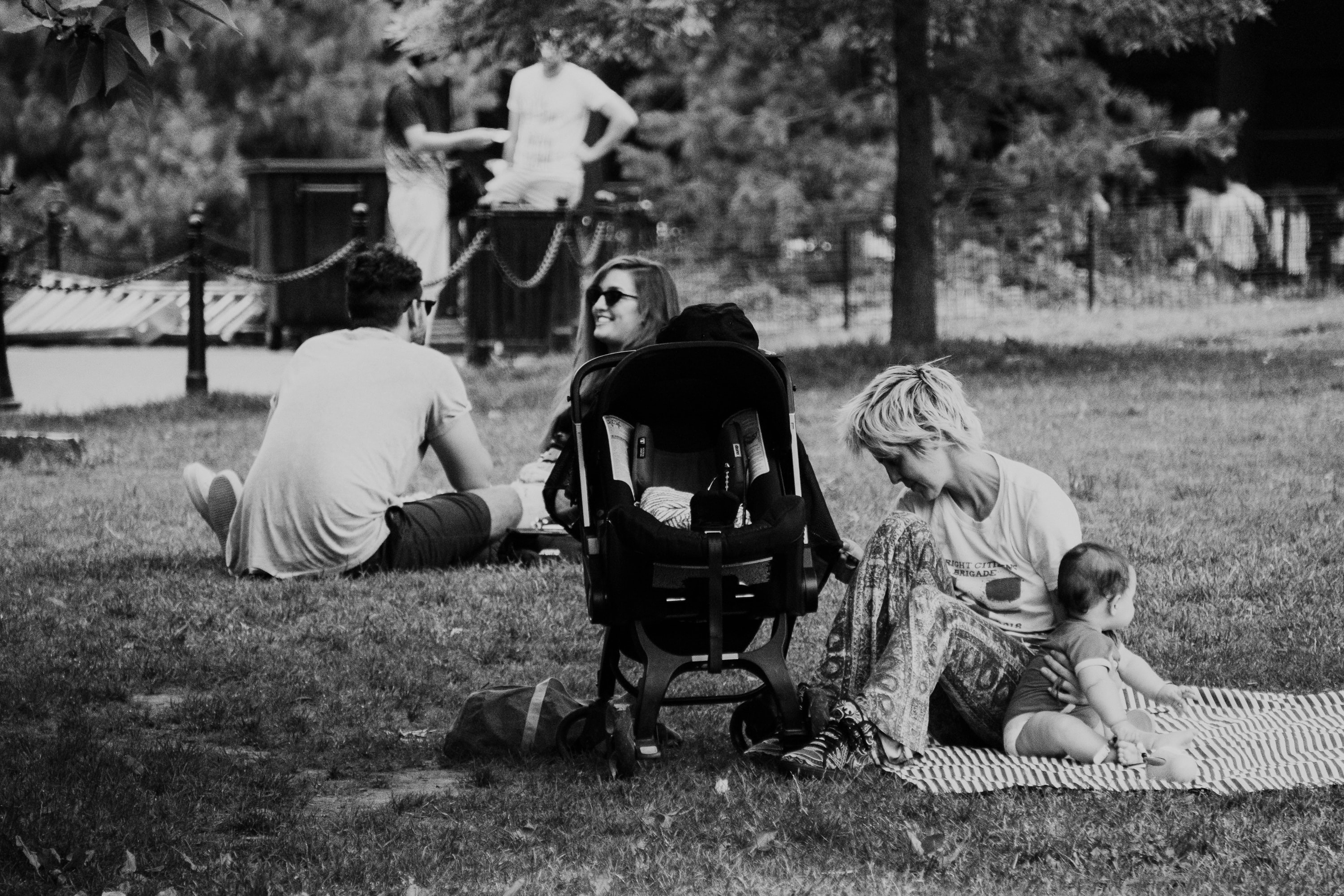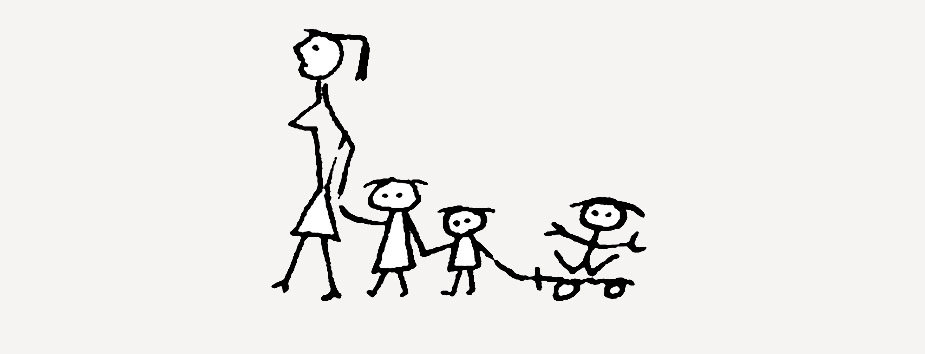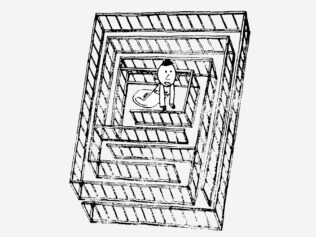
A wonderful sunny day in the park. I sat on a bench, was about to reach for my phone, but realized that the day was simply too beautiful and instead stared at the branches above. From the corner of my eye, I noticed a mother with her baby sat on the next bench along and I briefly glanced towards them before returning to slowly, gently breathing in the late spring.
I suppose I should have picked up on the sounds, but I admit that I didn’t. The child was communicating with its mother and the mother was responding with some sort of “ahm, yes, ahm”, more like an official who you happen to have disturbed in the middle of some important task. When I finally began paying attention and looked over at them, the child in the high pushchair was fighting with its hand, face and entire body for its mother’s attention. You know – smiles, frowns, pulling faces and getting upset. The mother responded, but somehow absently – that was what I first thought – with a kind of delay, almost wrongly. There was something odd about the scene and I didn’t understand exactly what until I stood up. Her crossed leg meant I hadn’t seen that the mother was not looking at the baby but at her phone, clearly engrossed in some deep exchange of messages or, judging by her twitching thumb, flicking through Instagram. Her reactions were a mixture of both (very many) responses to the screen and (very few) to her offspring.
How do we know that we’re angry? Sad? Happy? Disappointed? How do we recognize the entire spectrum of emotions that we are overcome with? We certainly have an inbred bodily response, but if you think about it, it is rather limited – chemicals are released into the blood, the excitement surges, the heart rate increases, and so on. How do we differentiate all these nuances and how are we able to name them? While we are born with the basic emotions, what about combinations of two or three of these?
We simply need to learn how to recognize emotions. This, of course, we do through body language, and the most expressive in this respect is the face with its enormous range of all kinds of nuances that are revealed through the micro-movements of our facial muscles.
In her book The Female Brain, Louann Brizendine reports on an experiment in which mothers and children were videotaped – it was noted that daughters sought contact with their mother 20 times more often than sons, suggesting that their emotional transfer is also much stronger. With regards to the example from the park, I can only hope that the child was not a girl, in which case the consequences will be so much worse.
On the face of it, children today get much more attention than they have ever had throughout history. How much of this attention, however, is undivided? The kind where the eyes lock and reflection is unhindered? When an emotional link is established, not just a physical presence? When bodies are linked in the same rhythm and emotion? As parents we are present physically, but not emotionally.
I knew a woman who was incapable of this link even in the era before mobile phones. She would always talk to her children in front of the TV, in the cinema or while driving – situations where she could look at something else. When the children were a little older and would say, “Mum, I’d like to talk to you,” she always obliged with a suggestion: “Right, let’s go for a drive.”
Much has been written about how harmful the internet is for children, but we know surprisingly little about children whose parents cheat on them with social networks.
We know what happens if there is no contact at all. For example, from research on inflammatory processes in the bodies of adults (which suggests that childhood psychosocial stressors can affect immune system development, which in turn can affect brain development and its long-term functioning), and particularly from the unfortunate children in Romanian orphanages (after Nicolae Ceauşescu banned abortion and contraception in an attempt to increase the birth rate, almost 170,000 children were left in ‘child gulags’ without basic sanitation, even tied to their beds, left in their own urine, endlessly hitting themselves and screaming.)
In an admittedly less desperate situation, one American TV star explains how she realizes that her Botox is wearing off whenever her kids ask why she is mad at them (because she’s frowning!), after which she rushes off for a new dose. Botox numbs the muscles and subsequently also the ability to express ourselves through micro-emotional movements. Children with Botoxed parents are thus likely to learn less and their emotional range is narrower – there have already been studies that confirm this hypothesis. This leads to less emotional exchange between adults and, as a result, less empathy.
In the park, however, I was witness to something entirely different: the wrong exchange of emotions. The child is upset – the mother is delighted when she receives a message on her phone. The child adapts to the joy – the mother is already at the next message, which is uninteresting, so she shows boredom. This I have found no research about; it is new. So far, children have had differing degrees of contact. Now there are some who are learning emotions inconsistently or in the wrong way – on one occasion, a smile will return contempt, yet on another it will signify approval.
Right now, a remarkable experiment is taking place around the whole world. Children send a signal and get a chance response (depending on what is on the parent’s screen at that moment). Will their world be even less predictable? Will they become adults full of anxiety and uncertainty? Will they seem uncanny to those brought up differently? Eerily unheimlich, as described by Freud; familiar and strange, human and robotic at the same time?
Will they too prefer to withdraw to a screen where the selection of emotions is manageable and unambiguous? They need only learn the language of emojis and everything is clear. Already we can read newspaper headlines such as: “Average Adult Will Spend 34 Years Of Their Life Staring At Screens”. This means that there is unlikely to be much ‘live debauchery’ (to quote another headline: “Studies show that young men in the US are having a lot less sex than previous generations”) and gives rise to the possibility that sex robots will provide a solution. After all, such robots ‘are almost like humans’ – especially if you are incapable of picking up on the nuances in expressions that robots lack anyway.
Moving back to the youngest generation, recent research from the U.S Bureau of Labor Statistics shows that parents are playing with children aged under age six for less then 40 minutes per day (not including sports). The most pressing question then, if we are to avoid raising our children as robots, is: can we do that 40 minutes without using our smartphones?

Translated from the Slovenian by Gregor Timothy Čeh
A previous version of this column was published in Slovenian on Siol.net










